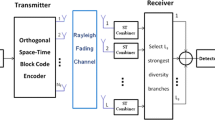Abstract
In this correspondence, we develop a framework to analyze the symbol error probability (SEP) of downlink multiuser diversity (MUD) transmit antenna selection with orthogonal space-time block codes (TAS/OSTBC) over Rayleigh fading channels. Two excellent transmit antennas are chosen that maximize the received signal-to-noise level. Utilizing the moment generating function, a tight closed-form analytical expression of MUD order is derived in terms of SEP. The results shows that the MUD system can achieve a gain of diversity equal to the product of the number of users, number of transmit antennas and number of receive antennas.




Similar content being viewed by others
References
Alamouti, S. M. (1998). A simple transmit diversity technique for wireless communication. IEEE Journal Selected Areas in Communication, 16(8), 1451–1458.
Tarokh, V. H., Jafarkhani, H., & Calderbank, A. R. (1999). Space-time block codes from orthogonal designs. IEEE Transactions on Information Theory, 45(5), 1456–1467.
Chauhan, S. S., & Kumar, S. (2014). Capacity analysis of adaptive transmission with space-time block codes in spatially correlated MIMO Nakagami-m fading channels. Wireless Personal Communications, 79(2), 1211–1222.
Gore, D. A., & Paulraj, A. (2002). MIMO antenna subset selection with space-time coding. IEEE Transactions on Signal Processing, 50(10), 2580–2588.
Chen, Z., Yuan, J., Vucetic, B., & Zhou, Z. (2003). Performance of the Alamouti scheme with transmit antenna selection. Electronics Letters, 39(23), 1666–1668.
Kaviani, S., & Tellambura, C. (2006). Closed-form BER analysis for antenna selection using orthogonal space-time block codes. IEEE Communications Letters, 10(10), 704–706.
Phan, K. T., & Tellambura, C. (2007). Capacity analysis for transmit antenna selection using orthogonal space-time block codes. IEEE Communications Letters, 11(5), 423–425.
Gozali, R., Buehrer, R. M., & Woerner, B. D. (2003). The impact of multiuser diversity on space-time block coding. IEEE Communications Letters, 7(5), 213–215.
Jiang, J., Buehrer, R. M., & Tranter, W. H. (2004). Antenna diversity in multiuser data networks. IEEE Transactions on Communications, 52(3), 490–497.
Larsson, E. G. (2004). On the combination of spatial diversity and multiuser diversity. IEEE Communications Letters, 8(8), 517–519.
Ajib, W., & Haccoun, D. (2005). An overview of scheduling algorithms in MIMO-based fourth-generation wireless systems. IEEE Network, 19(5), 43–48.
Zhang, X., Lv, Z., & Lang, W. (2008). Performance analysis of multiuser diversity in MIMO systems with antenna selection. IEEE Transactions on Wireless Communications, 7(1), 15–21.
Lee, D., & Kim, K. (2009). Error probability analysis of combining space-time block coding and scheduling in MIMO systems. IEEE Signal Processing Letters, 16(12), 1071–1074.
Lin, P. H., & Tsai, S. H. (2012). Performance analysis and algorithm designs for transmit antenna selection in linearly precoded multiuser MIMO systems. IEEE Transactions on Vehicular Technology, 61(4), 1698–1708.
Lee, D. (2013). Performance analysis of ZF-precoded scheduling system for MU-MIMO with generalized selection criterion. IEEE Transactions on Wireless Communications, 12(4), 1812–1818.
Proakis, J. G. (2000). Digital communication (4th ed.). New York: McGraw-Hill.
Gradshteyn, I. S., & Ryzhik, I. M. (2000). Table of integrals, series, and products (6th ed.). San Diego, CA: Academic.
Bahceci, I., Duman, T. M., & Altunbasak, Y. (2003). Antenna selection for multiple antenna transmission system: Performance analysis and code construct. IEEE Transactions on Information Theory, 49, 2669–2681.
Simon, M. K., & Alouini, M. S. (2000). Digital communication over fading channels: A unified approach to performance analysis. New York: Wiley.
Exton, H. (1976). Multiple hypergeometric functions and applications. New York: Wiley.
Author information
Authors and Affiliations
Corresponding author
Rights and permissions
About this article
Cite this article
Chauhan, S.S., Kumar, S. Unified symbol error probability analysis of multiuser diversity in TAS/OSTBC systems. Telecommun Syst 62, 603–609 (2016). https://doi.org/10.1007/s11235-015-0097-3
Published:
Issue Date:
DOI: https://doi.org/10.1007/s11235-015-0097-3




